Capital Budgeting & Investment Analysis: Managerial Finance Case
VerifiedAdded on 2023/06/10
|11
|1213
|305
Case Study
AI Summary
This case study solution for a Managerial Finance assignment involves analyzing investment decisions for an Australian defense firm. It includes calculating the weighted average cost of capital (WACC) considering various debt and equity components. The analysis evaluates two investment offers: one involving investment in new machinery and working capital for duffel bag production, and another involving selling land after development. The solution recommends pursuing the duffel bag production due to its positive NPV. Furthermore, the case addresses a replacement decision between an existing and a new machine, advocating for the replacement based on a positive NPV, indicating increased profitability. Desklib offers a wealth of similar solved assignments and study materials to aid students in their academic pursuits.
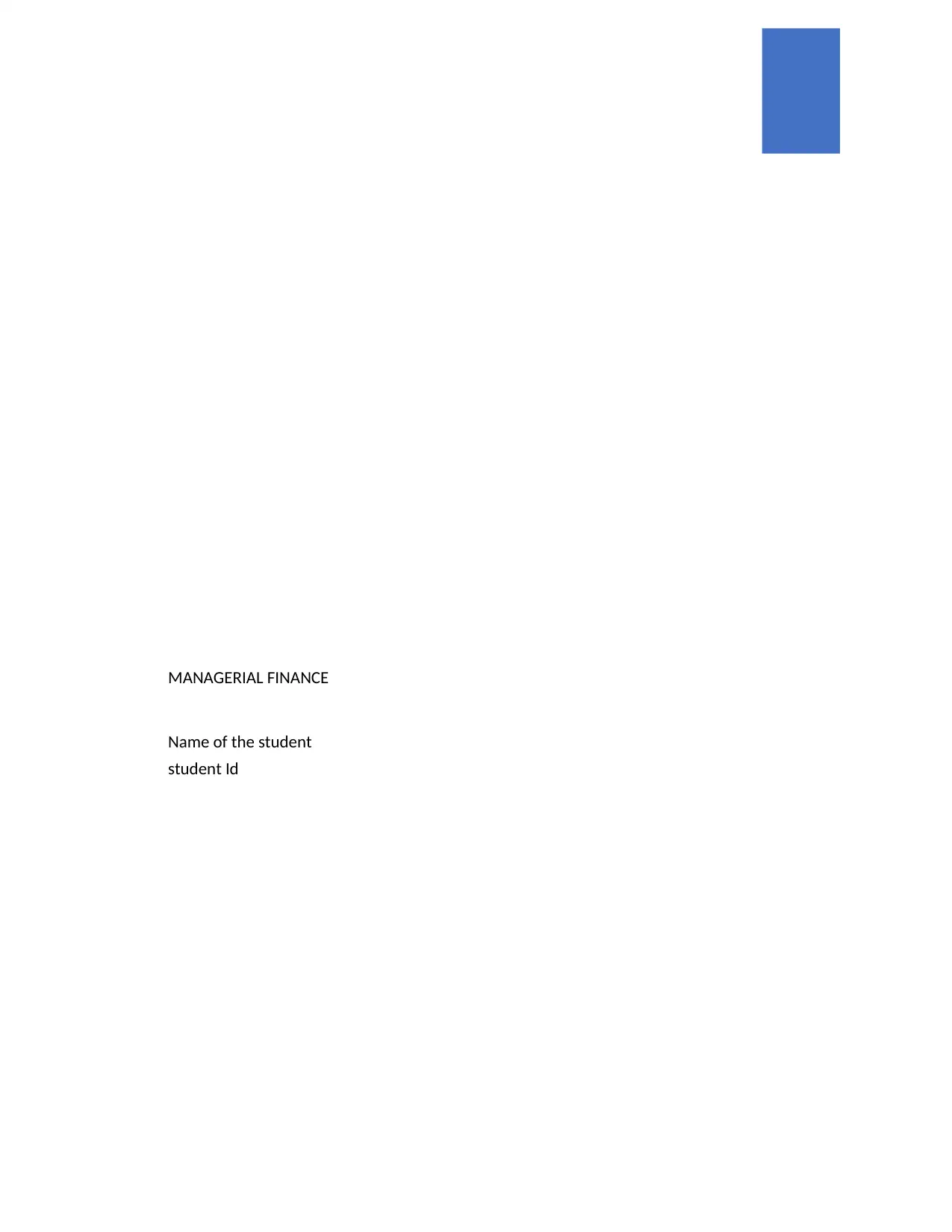
MANAGERIAL FINANCE
Name of the student
student Id
Name of the student
student Id
Paraphrase This Document
Need a fresh take? Get an instant paraphrase of this document with our AI Paraphraser
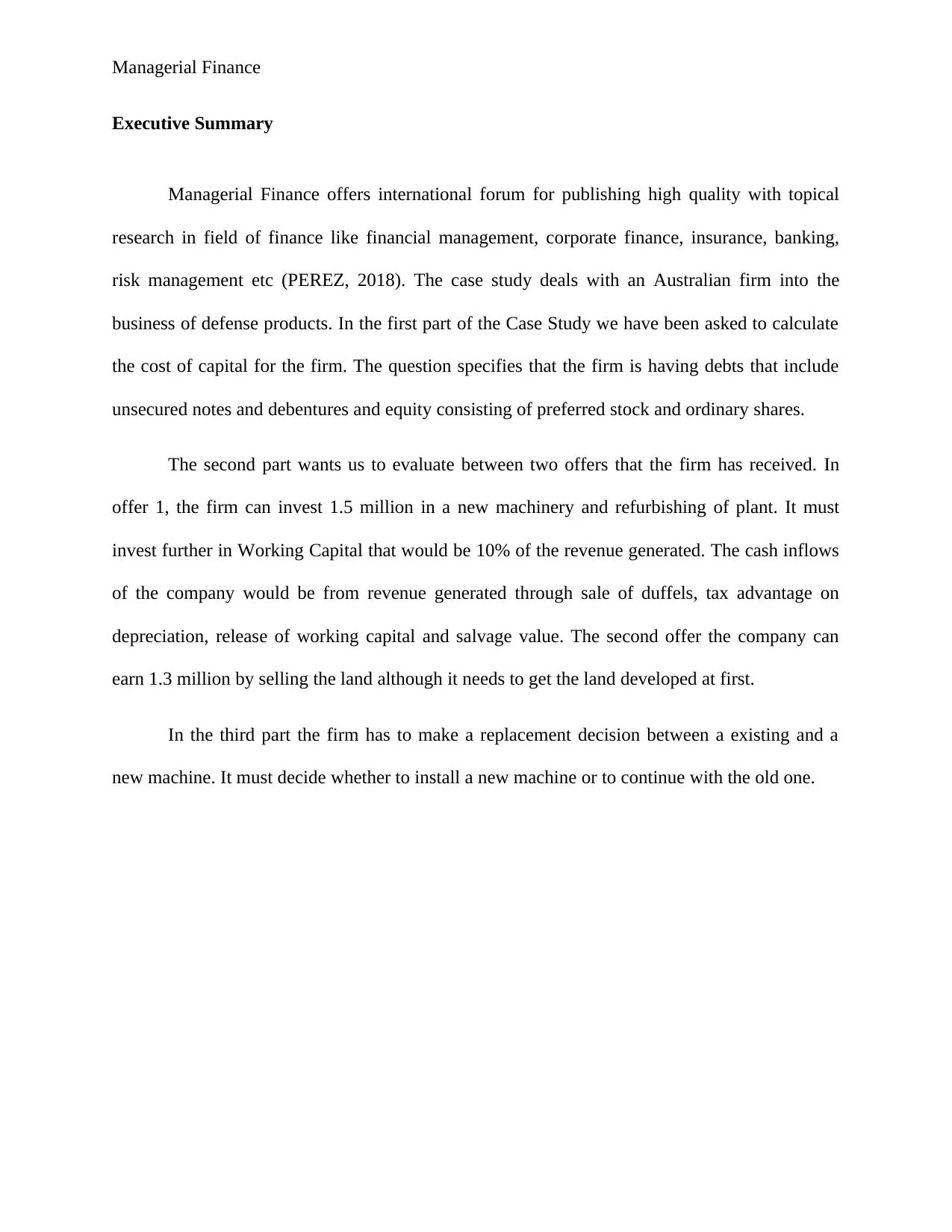
Managerial Finance
Executive Summary
Managerial Finance offers international forum for publishing high quality with topical
research in field of finance like financial management, corporate finance, insurance, banking,
risk management etc (PEREZ, 2018). The case study deals with an Australian firm into the
business of defense products. In the first part of the Case Study we have been asked to calculate
the cost of capital for the firm. The question specifies that the firm is having debts that include
unsecured notes and debentures and equity consisting of preferred stock and ordinary shares.
The second part wants us to evaluate between two offers that the firm has received. In
offer 1, the firm can invest 1.5 million in a new machinery and refurbishing of plant. It must
invest further in Working Capital that would be 10% of the revenue generated. The cash inflows
of the company would be from revenue generated through sale of duffels, tax advantage on
depreciation, release of working capital and salvage value. The second offer the company can
earn 1.3 million by selling the land although it needs to get the land developed at first.
In the third part the firm has to make a replacement decision between a existing and a
new machine. It must decide whether to install a new machine or to continue with the old one.
Executive Summary
Managerial Finance offers international forum for publishing high quality with topical
research in field of finance like financial management, corporate finance, insurance, banking,
risk management etc (PEREZ, 2018). The case study deals with an Australian firm into the
business of defense products. In the first part of the Case Study we have been asked to calculate
the cost of capital for the firm. The question specifies that the firm is having debts that include
unsecured notes and debentures and equity consisting of preferred stock and ordinary shares.
The second part wants us to evaluate between two offers that the firm has received. In
offer 1, the firm can invest 1.5 million in a new machinery and refurbishing of plant. It must
invest further in Working Capital that would be 10% of the revenue generated. The cash inflows
of the company would be from revenue generated through sale of duffels, tax advantage on
depreciation, release of working capital and salvage value. The second offer the company can
earn 1.3 million by selling the land although it needs to get the land developed at first.
In the third part the firm has to make a replacement decision between a existing and a
new machine. It must decide whether to install a new machine or to continue with the old one.
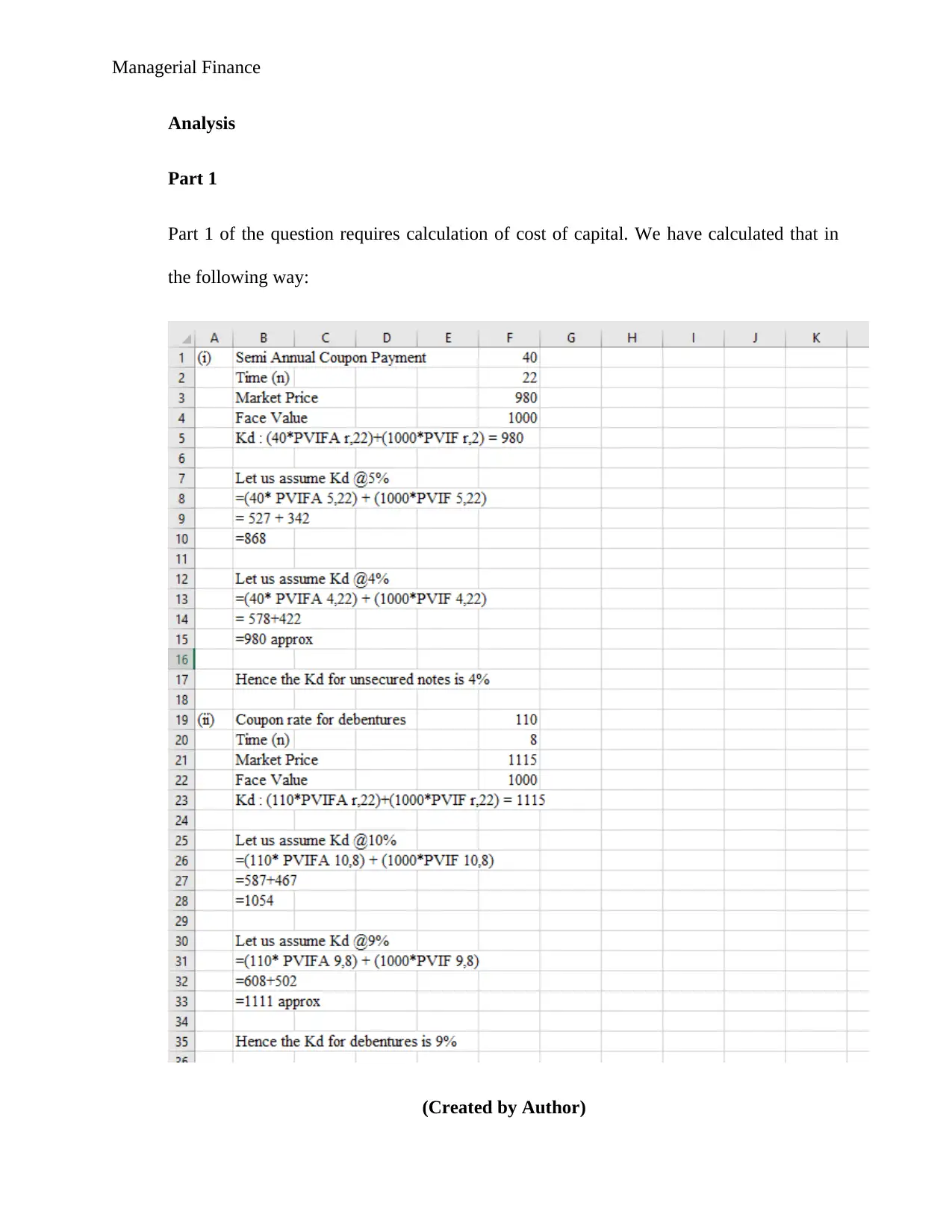
Managerial Finance
Analysis
Part 1
Part 1 of the question requires calculation of cost of capital. We have calculated that in
the following way:
(Created by Author)
Analysis
Part 1
Part 1 of the question requires calculation of cost of capital. We have calculated that in
the following way:
(Created by Author)
⊘ This is a preview!⊘
Do you want full access?
Subscribe today to unlock all pages.

Trusted by 1+ million students worldwide
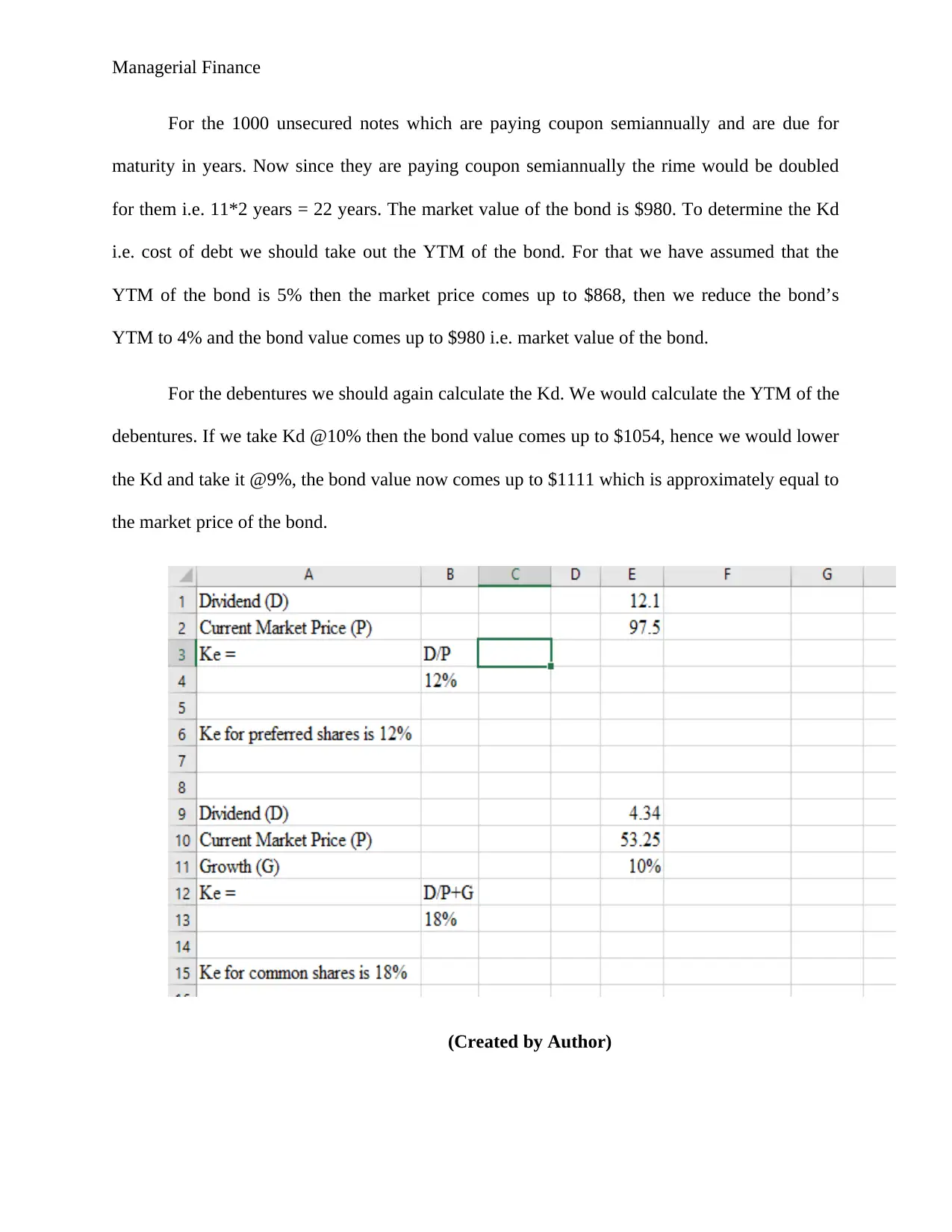
Managerial Finance
For the 1000 unsecured notes which are paying coupon semiannually and are due for
maturity in years. Now since they are paying coupon semiannually the rime would be doubled
for them i.e. 11*2 years = 22 years. The market value of the bond is $980. To determine the Kd
i.e. cost of debt we should take out the YTM of the bond. For that we have assumed that the
YTM of the bond is 5% then the market price comes up to $868, then we reduce the bond’s
YTM to 4% and the bond value comes up to $980 i.e. market value of the bond.
For the debentures we should again calculate the Kd. We would calculate the YTM of the
debentures. If we take Kd @10% then the bond value comes up to $1054, hence we would lower
the Kd and take it @9%, the bond value now comes up to $1111 which is approximately equal to
the market price of the bond.
(Created by Author)
For the 1000 unsecured notes which are paying coupon semiannually and are due for
maturity in years. Now since they are paying coupon semiannually the rime would be doubled
for them i.e. 11*2 years = 22 years. The market value of the bond is $980. To determine the Kd
i.e. cost of debt we should take out the YTM of the bond. For that we have assumed that the
YTM of the bond is 5% then the market price comes up to $868, then we reduce the bond’s
YTM to 4% and the bond value comes up to $980 i.e. market value of the bond.
For the debentures we should again calculate the Kd. We would calculate the YTM of the
debentures. If we take Kd @10% then the bond value comes up to $1054, hence we would lower
the Kd and take it @9%, the bond value now comes up to $1111 which is approximately equal to
the market price of the bond.
(Created by Author)
Paraphrase This Document
Need a fresh take? Get an instant paraphrase of this document with our AI Paraphraser
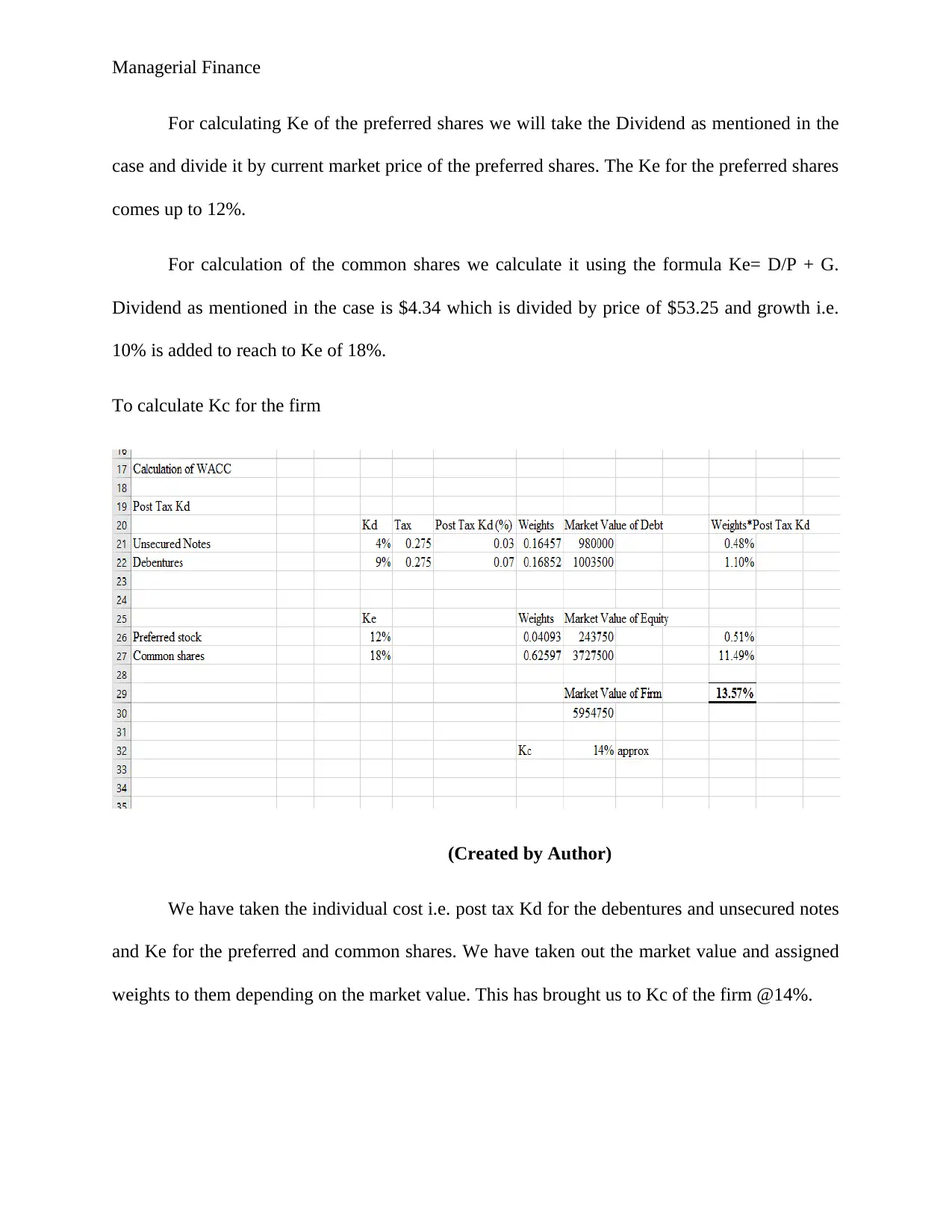
Managerial Finance
For calculating Ke of the preferred shares we will take the Dividend as mentioned in the
case and divide it by current market price of the preferred shares. The Ke for the preferred shares
comes up to 12%.
For calculation of the common shares we calculate it using the formula Ke= D/P + G.
Dividend as mentioned in the case is $4.34 which is divided by price of $53.25 and growth i.e.
10% is added to reach to Ke of 18%.
To calculate Kc for the firm
(Created by Author)
We have taken the individual cost i.e. post tax Kd for the debentures and unsecured notes
and Ke for the preferred and common shares. We have taken out the market value and assigned
weights to them depending on the market value. This has brought us to Kc of the firm @14%.
For calculating Ke of the preferred shares we will take the Dividend as mentioned in the
case and divide it by current market price of the preferred shares. The Ke for the preferred shares
comes up to 12%.
For calculation of the common shares we calculate it using the formula Ke= D/P + G.
Dividend as mentioned in the case is $4.34 which is divided by price of $53.25 and growth i.e.
10% is added to reach to Ke of 18%.
To calculate Kc for the firm
(Created by Author)
We have taken the individual cost i.e. post tax Kd for the debentures and unsecured notes
and Ke for the preferred and common shares. We have taken out the market value and assigned
weights to them depending on the market value. This has brought us to Kc of the firm @14%.
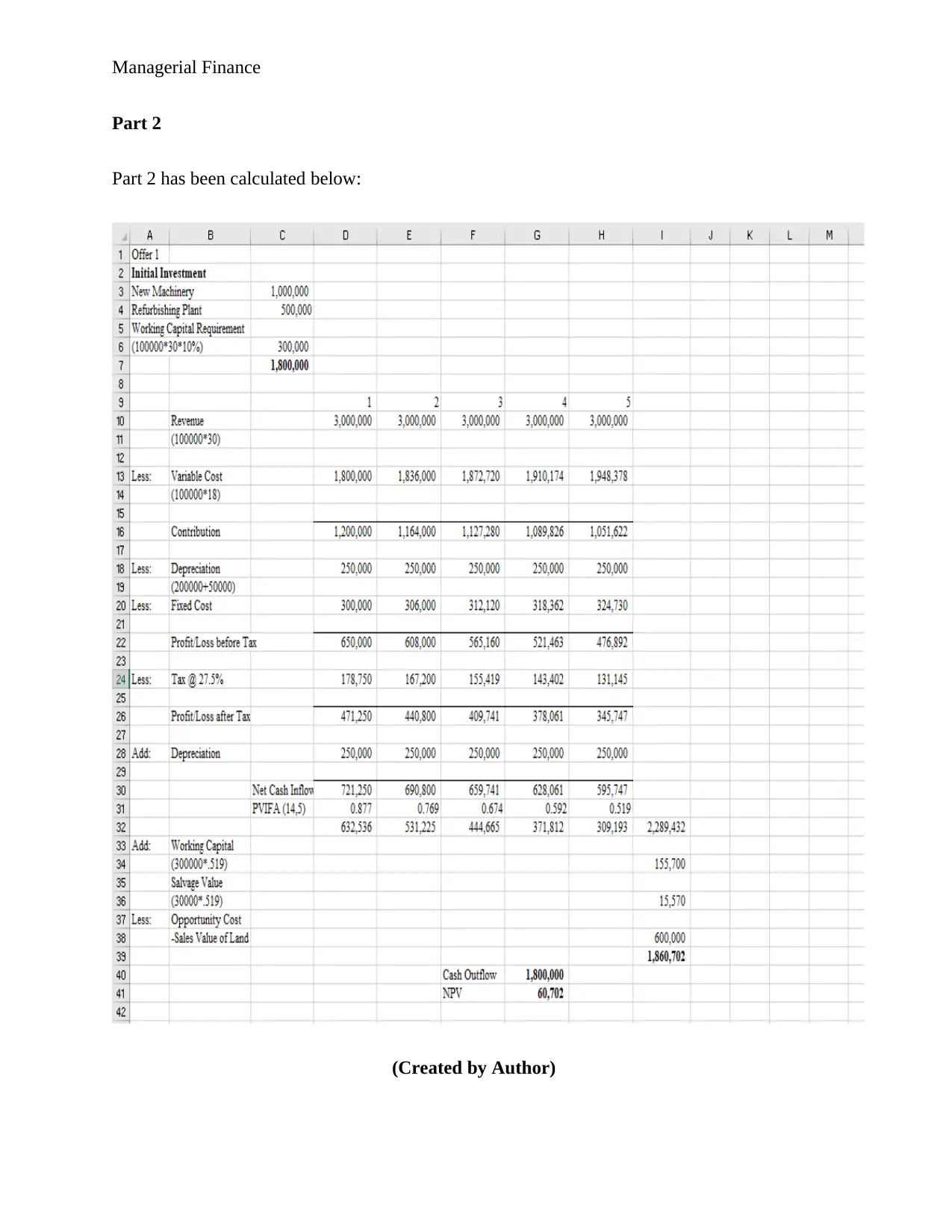
Managerial Finance
Part 2
Part 2 has been calculated below:
(Created by Author)
Part 2
Part 2 has been calculated below:
(Created by Author)
⊘ This is a preview!⊘
Do you want full access?
Subscribe today to unlock all pages.

Trusted by 1+ million students worldwide
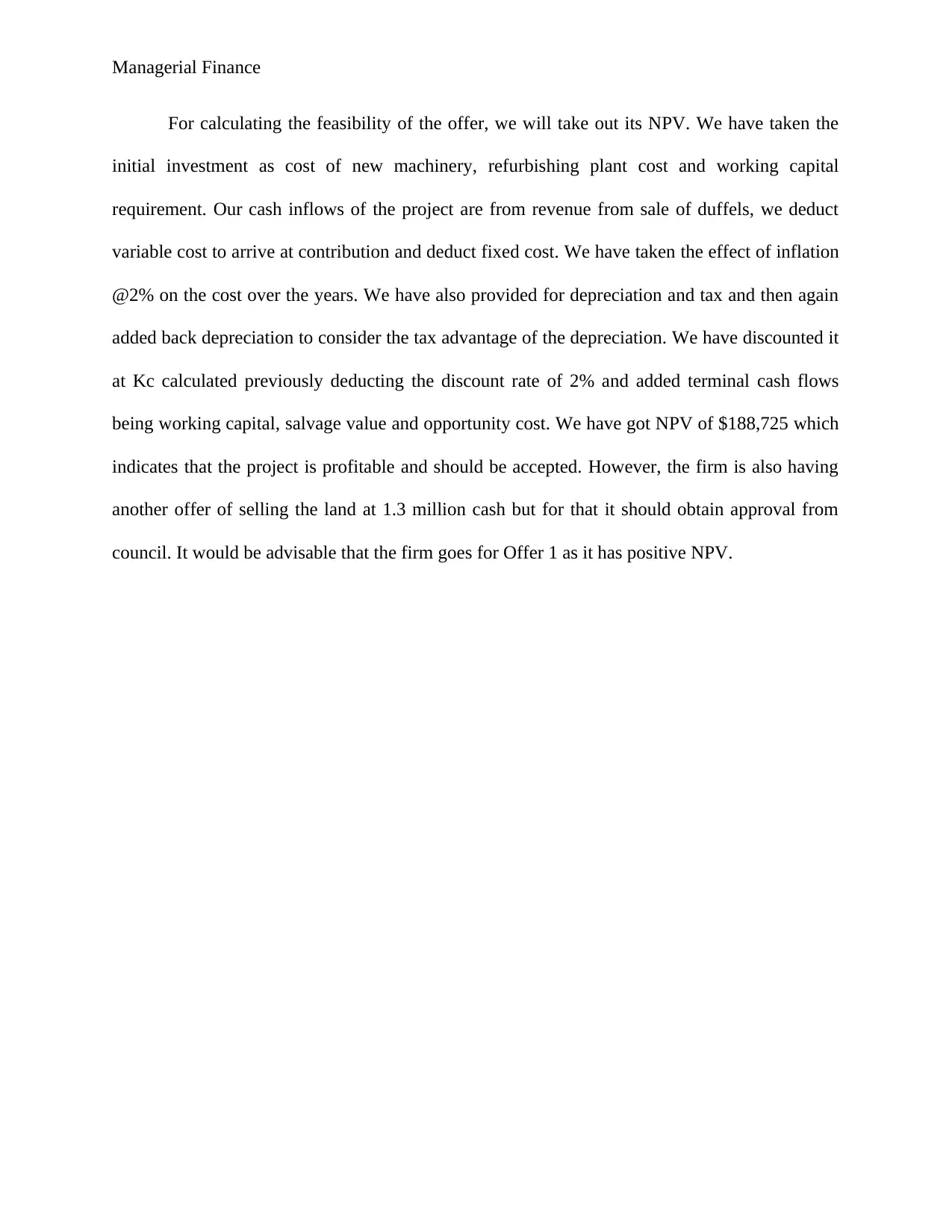
Managerial Finance
For calculating the feasibility of the offer, we will take out its NPV. We have taken the
initial investment as cost of new machinery, refurbishing plant cost and working capital
requirement. Our cash inflows of the project are from revenue from sale of duffels, we deduct
variable cost to arrive at contribution and deduct fixed cost. We have taken the effect of inflation
@2% on the cost over the years. We have also provided for depreciation and tax and then again
added back depreciation to consider the tax advantage of the depreciation. We have discounted it
at Kc calculated previously deducting the discount rate of 2% and added terminal cash flows
being working capital, salvage value and opportunity cost. We have got NPV of $188,725 which
indicates that the project is profitable and should be accepted. However, the firm is also having
another offer of selling the land at 1.3 million cash but for that it should obtain approval from
council. It would be advisable that the firm goes for Offer 1 as it has positive NPV.
For calculating the feasibility of the offer, we will take out its NPV. We have taken the
initial investment as cost of new machinery, refurbishing plant cost and working capital
requirement. Our cash inflows of the project are from revenue from sale of duffels, we deduct
variable cost to arrive at contribution and deduct fixed cost. We have taken the effect of inflation
@2% on the cost over the years. We have also provided for depreciation and tax and then again
added back depreciation to consider the tax advantage of the depreciation. We have discounted it
at Kc calculated previously deducting the discount rate of 2% and added terminal cash flows
being working capital, salvage value and opportunity cost. We have got NPV of $188,725 which
indicates that the project is profitable and should be accepted. However, the firm is also having
another offer of selling the land at 1.3 million cash but for that it should obtain approval from
council. It would be advisable that the firm goes for Offer 1 as it has positive NPV.
Paraphrase This Document
Need a fresh take? Get an instant paraphrase of this document with our AI Paraphraser
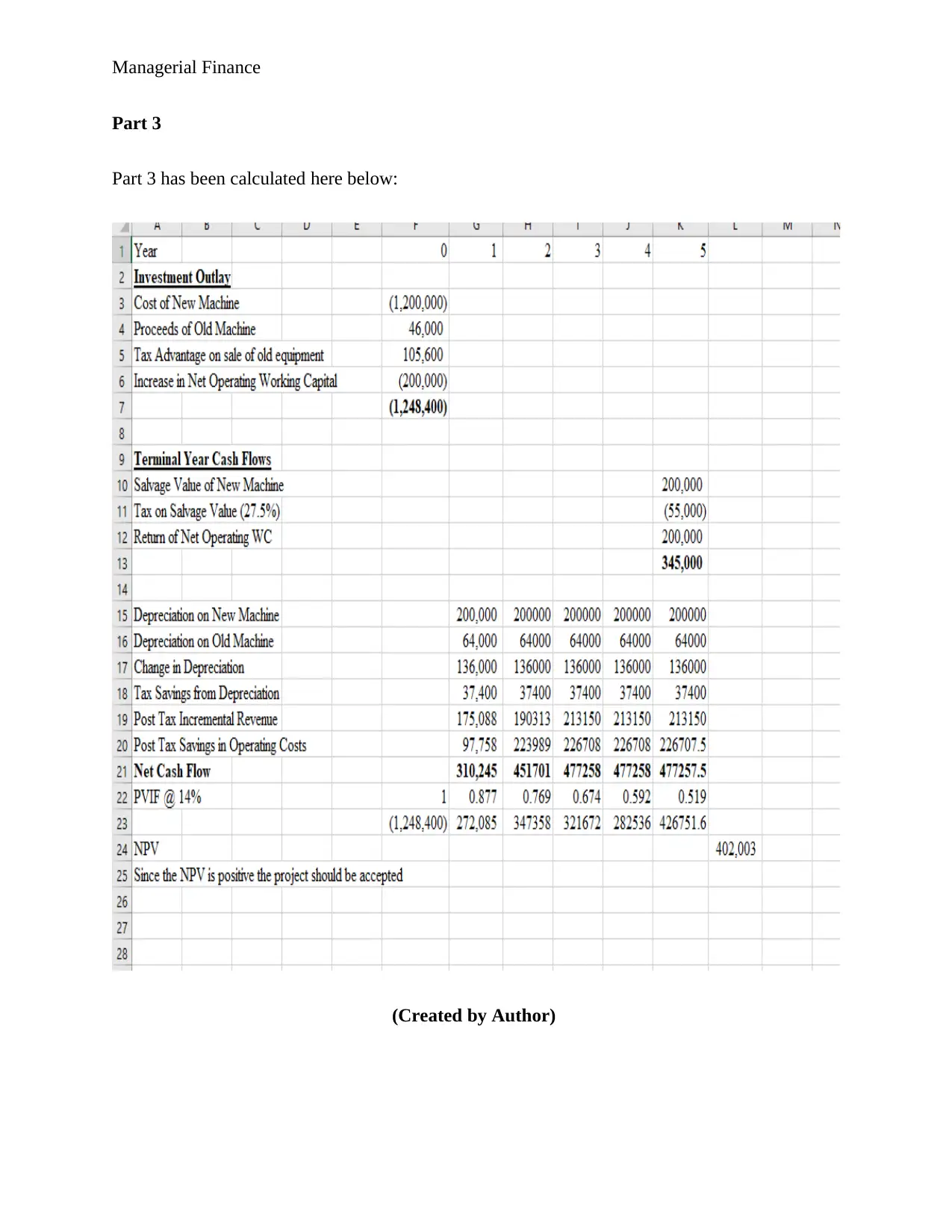
Managerial Finance
Part 3
Part 3 has been calculated here below:
(Created by Author)
Part 3
Part 3 has been calculated here below:
(Created by Author)
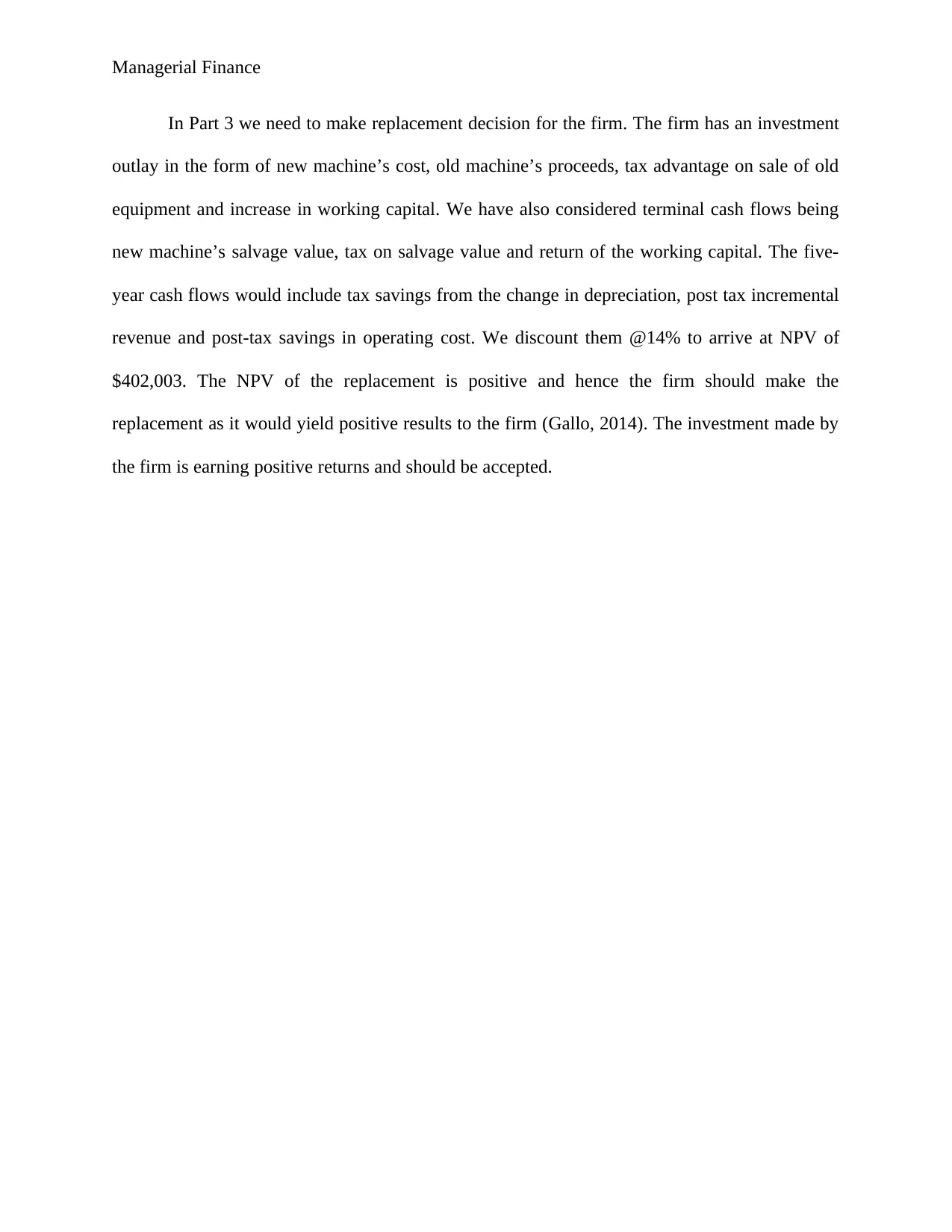
Managerial Finance
In Part 3 we need to make replacement decision for the firm. The firm has an investment
outlay in the form of new machine’s cost, old machine’s proceeds, tax advantage on sale of old
equipment and increase in working capital. We have also considered terminal cash flows being
new machine’s salvage value, tax on salvage value and return of the working capital. The five-
year cash flows would include tax savings from the change in depreciation, post tax incremental
revenue and post-tax savings in operating cost. We discount them @14% to arrive at NPV of
$402,003. The NPV of the replacement is positive and hence the firm should make the
replacement as it would yield positive results to the firm (Gallo, 2014). The investment made by
the firm is earning positive returns and should be accepted.
In Part 3 we need to make replacement decision for the firm. The firm has an investment
outlay in the form of new machine’s cost, old machine’s proceeds, tax advantage on sale of old
equipment and increase in working capital. We have also considered terminal cash flows being
new machine’s salvage value, tax on salvage value and return of the working capital. The five-
year cash flows would include tax savings from the change in depreciation, post tax incremental
revenue and post-tax savings in operating cost. We discount them @14% to arrive at NPV of
$402,003. The NPV of the replacement is positive and hence the firm should make the
replacement as it would yield positive results to the firm (Gallo, 2014). The investment made by
the firm is earning positive returns and should be accepted.
⊘ This is a preview!⊘
Do you want full access?
Subscribe today to unlock all pages.

Trusted by 1+ million students worldwide
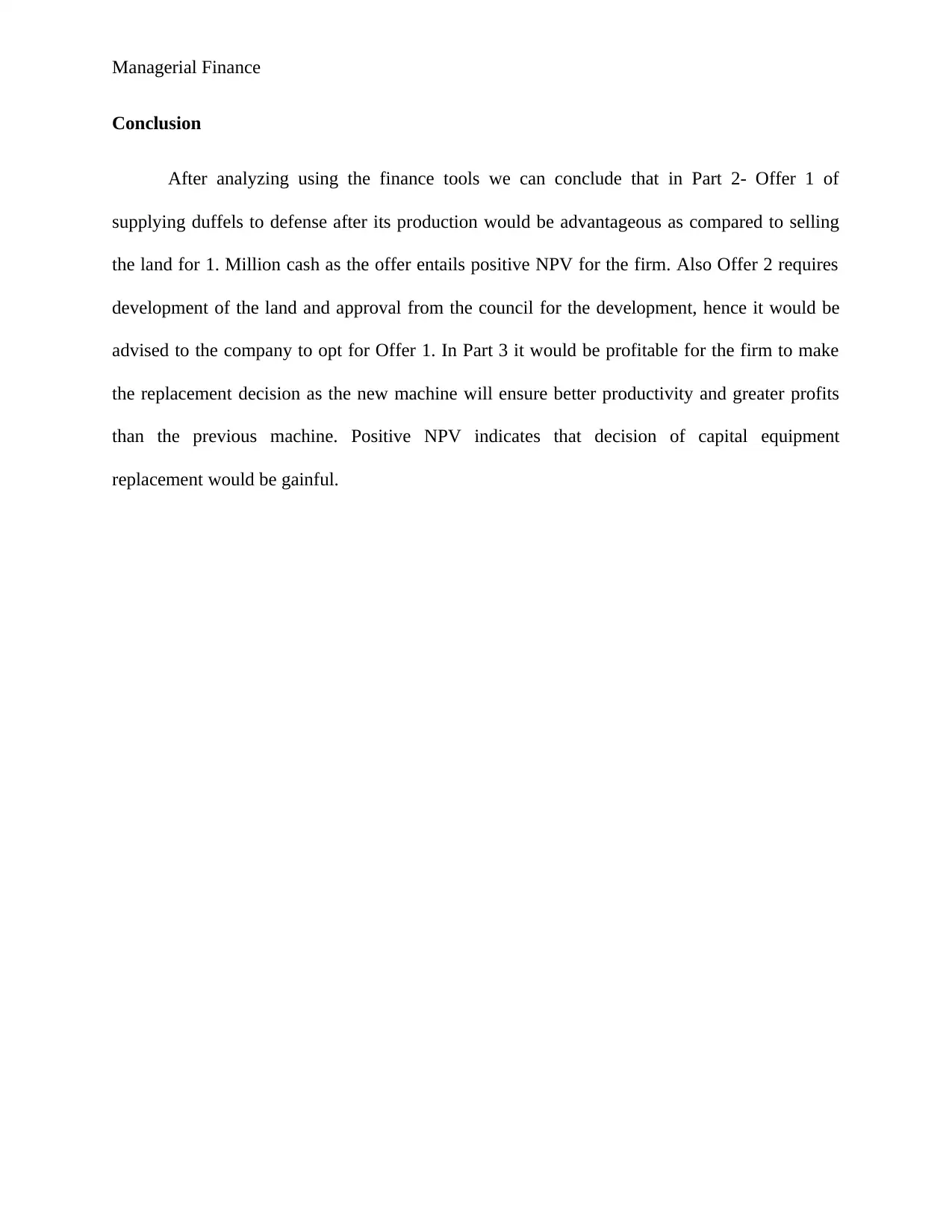
Managerial Finance
Conclusion
After analyzing using the finance tools we can conclude that in Part 2- Offer 1 of
supplying duffels to defense after its production would be advantageous as compared to selling
the land for 1. Million cash as the offer entails positive NPV for the firm. Also Offer 2 requires
development of the land and approval from the council for the development, hence it would be
advised to the company to opt for Offer 1. In Part 3 it would be profitable for the firm to make
the replacement decision as the new machine will ensure better productivity and greater profits
than the previous machine. Positive NPV indicates that decision of capital equipment
replacement would be gainful.
Conclusion
After analyzing using the finance tools we can conclude that in Part 2- Offer 1 of
supplying duffels to defense after its production would be advantageous as compared to selling
the land for 1. Million cash as the offer entails positive NPV for the firm. Also Offer 2 requires
development of the land and approval from the council for the development, hence it would be
advised to the company to opt for Offer 1. In Part 3 it would be profitable for the firm to make
the replacement decision as the new machine will ensure better productivity and greater profits
than the previous machine. Positive NPV indicates that decision of capital equipment
replacement would be gainful.
Paraphrase This Document
Need a fresh take? Get an instant paraphrase of this document with our AI Paraphraser
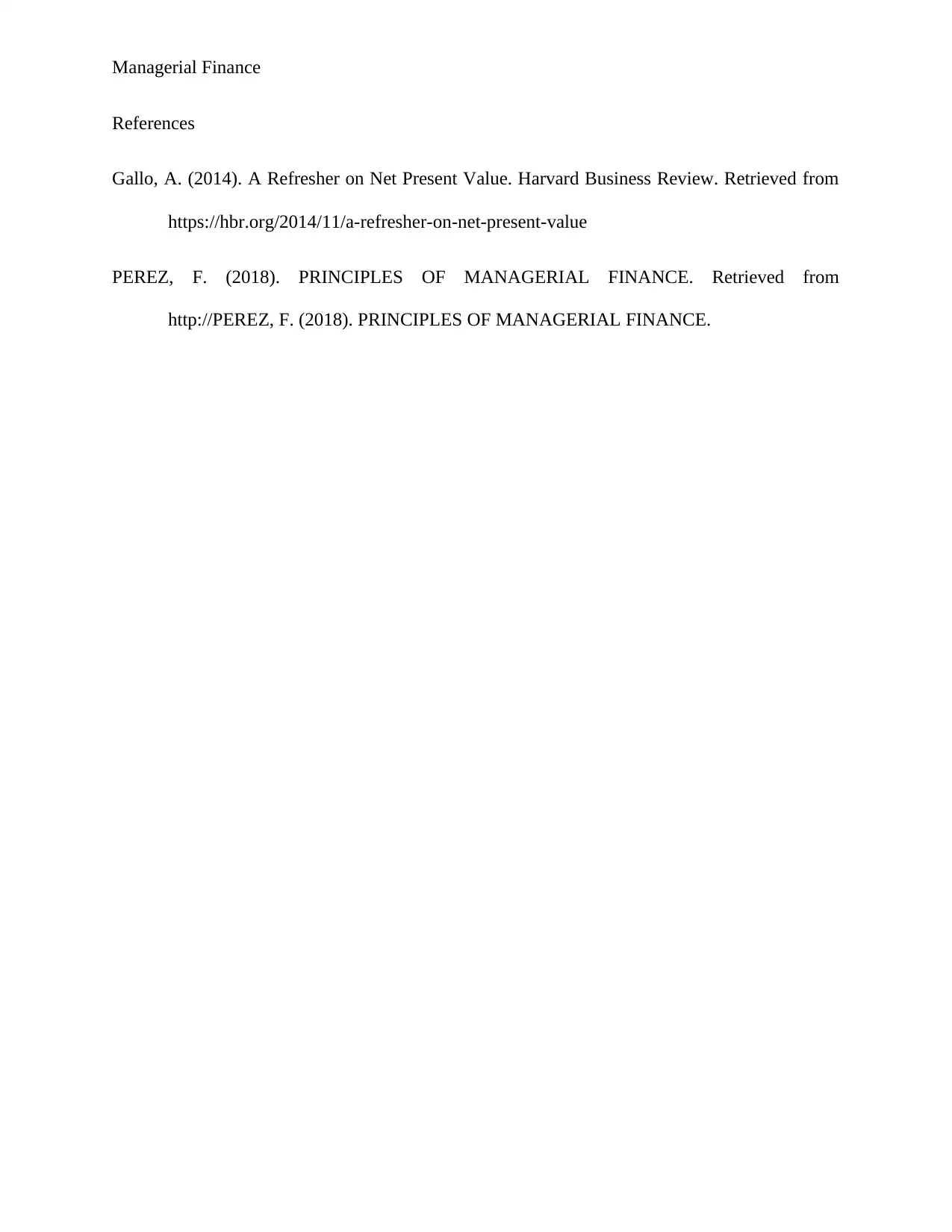
Managerial Finance
References
Gallo, A. (2014). A Refresher on Net Present Value. Harvard Business Review. Retrieved from
https://hbr.org/2014/11/a-refresher-on-net-present-value
PEREZ, F. (2018). PRINCIPLES OF MANAGERIAL FINANCE. Retrieved from
http://PEREZ, F. (2018). PRINCIPLES OF MANAGERIAL FINANCE.
References
Gallo, A. (2014). A Refresher on Net Present Value. Harvard Business Review. Retrieved from
https://hbr.org/2014/11/a-refresher-on-net-present-value
PEREZ, F. (2018). PRINCIPLES OF MANAGERIAL FINANCE. Retrieved from
http://PEREZ, F. (2018). PRINCIPLES OF MANAGERIAL FINANCE.
1 out of 11
Related Documents
Your All-in-One AI-Powered Toolkit for Academic Success.
+13062052269
info@desklib.com
Available 24*7 on WhatsApp / Email
![[object Object]](/_next/static/media/star-bottom.7253800d.svg)
Unlock your academic potential
Copyright © 2020–2025 A2Z Services. All Rights Reserved. Developed and managed by ZUCOL.





